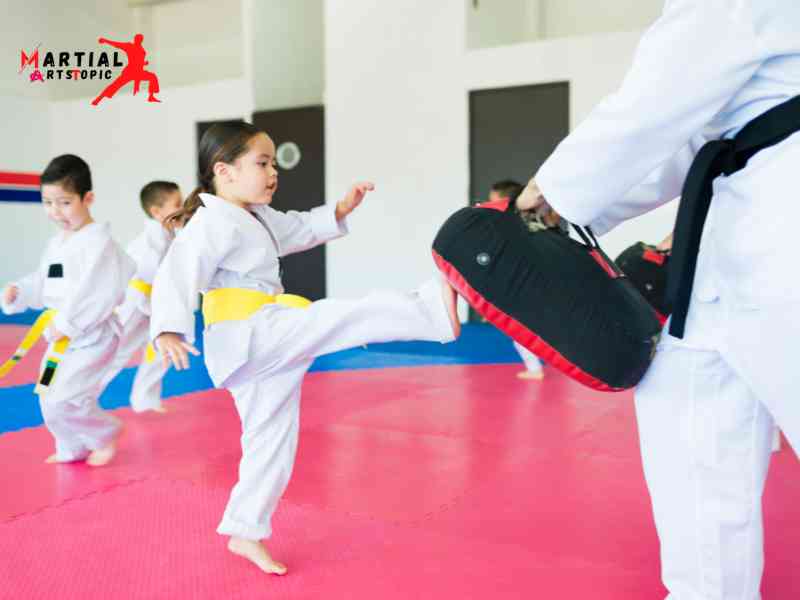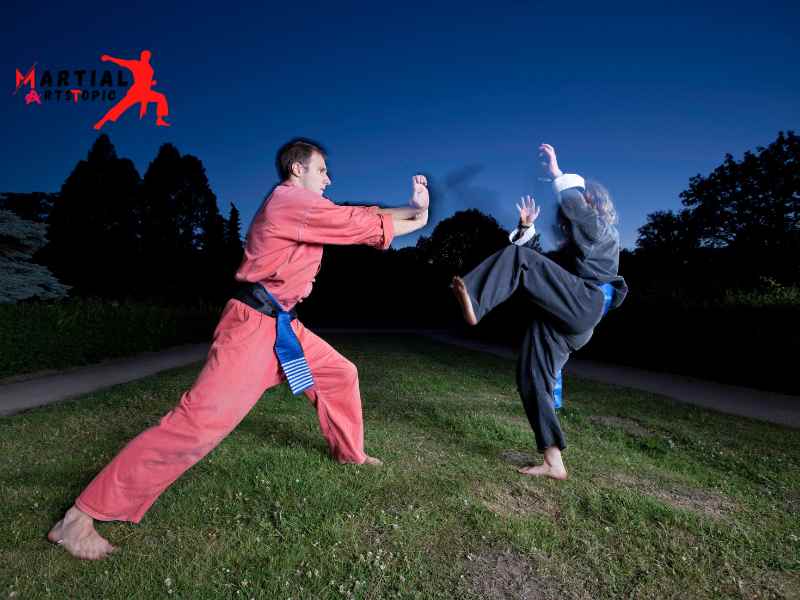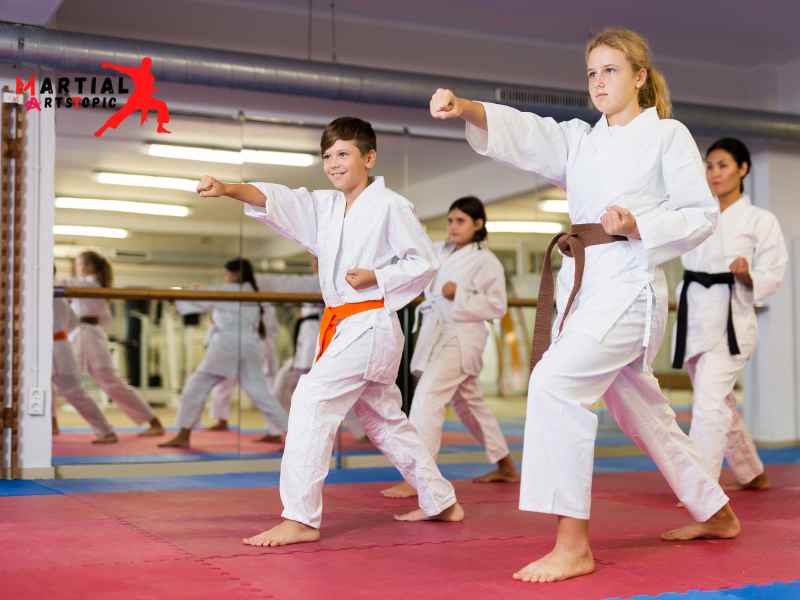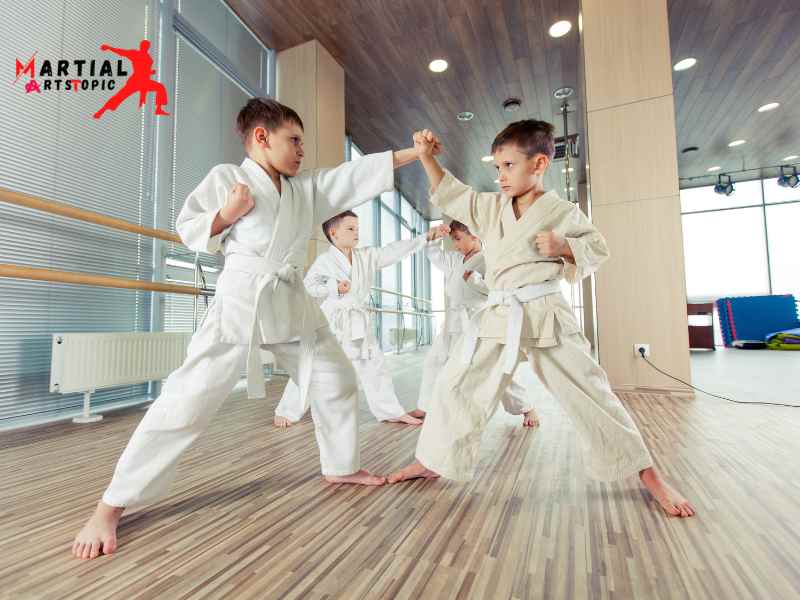
A Beginner’s Guide to Different Forms of Martial Arts
They have practiced forms of martial arts for centuries across the globe. From ancient traditions to modern styles, martial arts offer a unique combination of physical fitness, self-defense skills, and mental discipline. Whether you’re a beginner exploring the world of martial arts or a seasoned practitioner looking to expand your knowledge, this beginner’s guide will introduce you to different martial arts.
- Karate: Originating from Japan, Karate focuses on strikes, punches, kicks, and knee strikes. It emphasizes disciplined movements and the development of physical and mental strength. Karate practitioners also learn self-defense techniques and engage in sparring exercises.
- Judo: Developed in Japan, Judo is a grappling-based martial art that emphasizes throws and ground fighting. It uses an opponent’s strength and momentum to overcome them. Judo practitioners learn techniques to control and immobilize their opponents through pins and submissions.
- Taekwondo: Originating from Korea. They know Taekwondo for its high and fast kicks. It combines punches, kicks, and blocks into a fluid and dynamic martial art form. Taekwondo also includes patterns, or forms, which are a series of predetermined movements practiced developing technique and precision.
- Brazilian Jiu-Jitsu: Brazilian Jiu-Jitsu (BJJ) is a ground-based martial art that focuses on grappling and submission holds. It emphasizes leverage and technique over brute force, making it suitable for people of all sizes and strengths. BJJ practitioners learn how to defend themselves and gain control using joint locks and chokes.
- Muay Thai: Also known as “The Art of Eight Limbs,” Muay Thai originated in Thailand. It uses punches, kicks, elbows, and knee strikes, making it a highly effective striking martial art. Muay Thai training involves conditioning, paid work, and sparring to develop power, speed, and accuracy.
- Kung Fu: Kung Fu is a Chinese martial art that encompasses various styles, such as Wing Chun, Shaolin, and Tai Chi. It focuses on fluid movements, kicks, punches, and open-hand techniques. Kung Fu also incorporates meditation and philosophy to develop inner strength and balance.
- Krav Maga: Developed for the Israeli military, Krav Maga is a practical self-defense system designed for real-life situations. It combines techniques from boxing, judo, Muay Thai, and other martial arts to neutralize threats quickly and efficiently. Krav Maga training emphasizes realistic scenarios and effective self-defense techniques.
- Boxing: Known as the “sweet science,” boxing is a combat sport that involves punching techniques and footwork. It emphasizes agility, speed, and endurance. Boxing training includes shadow boxing, bag work, sparring, and conditioning exercises to develop technique and physical fitness.
- Capoeira: Originating in Brazil, Capoeira combines elements of martial arts, acrobatics, and dance. Fluid and rhythmic movements characterize it, kicks, sweeps, and takedowns. Capoeira practitioners engage in “roda,” a circular formation where they showcase their skills through interactive play.
- Kickboxing: Kickboxing is a hybrid martial art that combines elements of boxing and kicking techniques. It can include both full-contact and light-contact versions, depending on the training and competition rules. Kickboxing training focuses on developing power, speed, and accuracy in both punches and kicks.
As a beginner, it’s essential to find a martial art that aligns with your interests, goals, and physical abilities. Consider trying out different forms of martial arts and consulting with instructors to determine which one suits you best. Remember, martial arts offer more than just physical training; they also provide valuable life skills, discipline, and a sense of community. So, get started on your martial arts journey and discover the incredible world of self-defense, fitness, and personal growth.
The Ancient Origins of Martial Arts
Martial arts, physical and mental discipline, have captivated civilizations throughout history. From the graceful movements of Kung Fu to the strategic techniques of Judo, martial arts have evolved over centuries to become a fascinating aspect of human culture. In this blog, we dive deep into the origins of martial arts and explore the diverse forms they have taken throughout history.
Ancient China: Kung Fu and Tai Chi

I can trace the roots of martial arts back to ancient China, where they were deeply intertwined with philosophy, spirituality, and self-defense. Kung Fu, with its wide range of styles such as Wing Chun and Shaolin, emphasizes fluid movements, striking techniques, and self-control. Tai Chi focuses on slow, meditative movements promoting overall well-being and inner peace.
Ancient Japan: Samurai and Ninjutsu
In feudal Japan, martial arts played a crucial role in warfare and self-defense. The Samurai, skilled warriors of noble birth, practiced various martial arts disciplines such as Kenjutsu (swordsmanship) and Jujutsu (grappling techniques). Meanwhile, the secretive Ninjas developed Ninjutsu, an art centered on stealth, espionage, and unconventional combat tactics.
Ancient India: Kalaripayattu
Kalaripayattu, considered one of the oldest martial arts in the world, originated in the southern Indian state of Kerala. This ancient form focuses on physical conditioning, strikes, kicks, grappling, and weaponry. Kalaripayattu also incorporates healing techniques and mental training, making it a holistic art form.
Ancient Greece: Pankration
Dating back to ancient Greece, Pankration was a combat sport that combined elements of boxing and wrestling. It was a highly intense and brutal martial art, allowing competitors to use almost any technique to overpower their opponents. Pankration was showcased in the ancient Olympic Games and is recognized as one of the earliest forms of mixed martial arts.
Ancient Korea: Taekwondo
Taekwondo, the national martial art of Korea, has its roots in ancient Korean history. Combining powerful kicks, strikes, and blocks, it focuses on self-defense, discipline, and mental fortitude. Taekwondo gained global recognition and became an official Olympic sport in 2000.
Modern Evolution

As martial arts spread across continents, they continued to evolve and develop into many distinct forms, each with its unique philosophy, techniques, and cultural significance. From the acrobatic kicks of Capoeira in Brazil to the grappling techniques of Brazilian Jiu-Jitsu, the world witnessed the birth of various martial arts styles.
The rise of MMA (Mixed Martial Arts) in recent years has led to the integration and cross-training of different martial arts disciplines. Fighters now combine techniques from various forms, showcasing the effectiveness and fluidity of martial arts.
Classification Forms of martial arts
Forms of Martial Arts: Exploring the Classification martial arts has always captivated people with their grace, discipline, and power. From ancient times to the present-day, various forms of martial arts have developed and flourished across different cultures. In this blog post, we will delve into the classification of martial arts and explore the diverse forms that exist around the world.
Striking Martial Arts
Striking martial arts predominantly focus on punches, kicks, and knee or elbow strikes. These forms of martial arts emphasize speed, agility, and precision in striking techniques. Some popular, striking martial arts include:
- Karate: Originating from Japan, Karate is a striking martial art that involves punches, kicks, knee strikes, and open-hand techniques. It emphasizes discipline, self-defense, and character development.
- Taekwondo: Developed in Korea, Taekwondo is known for its high, fast kicks and spinning kicks. It emphasizes self-defense, mental discipline, and physical fitness.
- Muay Thai: Also known as the “Art of Eight Limbs,” Muay Thai uses punches, kicks, elbows, and knee strikes. Originating from Thailand, they know it for its powerful strikes and clinching techniques.
Grappling Martial Arts:
Grappling martial arts focus on controlling an opponent through various grappling techniques, such as throws, joint locks, and submissions. These forms of martial arts emphasize leverage, technique, and ground fighting skills. Some popular grappling martial arts include:
- Brazilian Jiu-Jitsu (BJJ): Developed from traditional Japanese Jiu-Jitsu, BJJ focuses on ground fighting and submissions. It emphasizes technique, leverage, and fluid transitions.
- Judo: Originating from Japan, Judo is a grappling martial art that emphasizes throws and takedowns. It promotes physical fitness, discipline, and self-defense.
- Wrestling: Wrestling is a combat sport that involves grappling techniques to gain control over an opponent. We know it for its strength, agility, and strategic approach.
Weapon-Based Martial Arts:
Weapon-based martial arts incorporate the use of traditional weapons such as swords, staffs, nunchaku, and knives. These forms of martial arts emphasize weapon handling skills, precision, and coordination. Some popular weapon-based martial arts include:
- Kendo: Originating from Japan, Kendo uses bamboo swords and protective armor. It focuses on discipline, respect, and the cultivation of a warrior spirit.
- Eskrima: Also known as Arnis or Kali, Eskrima is a Filipino martial art that incorporates sticks, knives, and empty-hand techniques. It emphasizes speed, coordination, and adaptability.
- Fencing: Fencing is a European martial art that involves thrusting techniques with a sword. It emphasizes strategy, agility, and quick reflexes.
These are just a few examples of the diverse forms of martial arts that exist worldwide. Each form has its own unique techniques, philosophies, and training methods. Whether you are interested in striking, grappling, or weapon-based martial arts, there is a form that suits your interests and goals.
A Guide to Different Martial Arts Styles and Techniques
Individuals seeking self-defense skills, physical fitness, and personal growth have practiced for centuries forms of martial arts. With many styles and techniques to choose from, it can be overwhelming for beginners to understand the differences and find the right one to pursue. In this comprehensive guide, we will explore various forms of martial arts, their unique characteristics, and the benefits they offer.
1. Karate: Karate originated in Japan and focuses on striking techniques using punches, kicks, knee strikes, and elbow strikes. It emphasizes discipline, self-control, and firm stances. Karateka (karate practitioners) develop physical strength, agility, and mental focus through rigorous training.
- Taekwondo: Originating in Korea. They know Taekwondo for its dynamic kicking techniques. It combines self-defense techniques with high-flying kicks, spinning kicks, and jumping kicks. Taekwondo also emphasizes self-discipline, respect, and self-improvement.
- Judo: Judo, meaning “gentle way” in Japanese, emphasizes throws and grappling techniques. It focuses on using an opponent’s strength and momentum against them. Judo practitioners learn how to control their opponents through leverage and technique rather than sheer force.
- Brazilian Jiu-Jitsu: Brazilian Jiu-Jitsu (BJJ) is a ground-based martial art that emphasizes submissions and grappling techniques. BJJ practitioners learn how to control opponents on the ground and apply joint locks and chokes effectively. We know it for providing smaller individuals with the ability to overcome larger opponents.
- Muay Thai: Muay Thai, also known as Thai Boxing, originated in Thailand and is a striking-based martial art. It uses punches, kicks, elbows, and knee strikes. We know Muay Thai for its intense conditioning, promoting overall physical fitness and incredibly striking power.
- Kung Fu: Kung Fu encompasses a wide range of Chinese martial arts styles. It focuses on fluid movements, acrobatics, and a variety of strikes, kicks, and throws. Kung Fu training often includes forms, which are choreographed sequences of movements displaying different techniques.
- Krav Maga: Krav Maga is a self-defense system developed by the Israeli military. It combines techniques from boxing, wrestling, judo, and Muay Thai. Krav Maga emphasizes efficient movements to neutralize threats quickly. We know it for its real-world applicability and effectiveness in self-defense situations.
- Capoeira: Capoeira is a Brazilian martial art that combines elements of dance, acrobatics, and music. Flowing movements characterized it, kicks, and sweeps. Capoeira is not only a martial art but also a cultural expression, promoting community, creativity, and self-expression.
- Wing Chun: Wing Chun is a Chinese martial art that focuses on close-range combat and self-defense. It emphasizes simultaneous attack and defense, using quick punches, kicks, and trapping techniques. Wing Chun practitioners develop sensitivity, speed, and precision in their movements.
- Boxing: Boxing is a combat sport that focuses solely on punches. It requires excellent footwork, hand-eye coordination, and defensive techniques. We know boxing for its cardiovascular benefits, improving overall physical fitness, and promoting discipline.
Each martial art style mentioned above offers unique techniques, training methods, and philosophies. When choosing a martial art, consider your personal goals, interests, and physical abilities. It is essential to find a qualified instructor and a supportive training environment to maximize your learning experience.
Whether you are looking to improve your self-defense skills, enhance your physical fitness, or embark on a journey of personal growth, exploring different forms of martial arts can be an exciting and rewarding endeavor. Start your martial arts journey today and discover the amazing benefits it can bring to your life.
How to Choose the Right Martial Art for You

In choosing the right martial art for you, the options can be overwhelming. With so many forms of martial arts to choose from, it’s important to find the one that aligns with your goals, interests, and physical abilities. In this blog post, we will explore the different martial arts and provide guidance on how to choose the right one for you.
- 1. Karate: Karate is a popular martial art that originated in Japan. It focuses on striking techniques, such as punches, kicks, knee strikes, and elbow strikes. We know karate for its emphasis on discipline, self-defense, and personal development.
- Taekwondo: Taekwondo is a Korean martial art that primarily focuses on high and fast kicks. We know it for its dynamic and flashy kicking techniques, as well as its emphasis on self-defense and competitive sparring. Taekwondo is a great choice for those who want to improve their flexibility, balance, and agility.
- Judo: Judo is a Japanese martial art that emphasizes throws and grappling techniques. We know it for its focus on leverage and technique rather than brute strength. Judo is an excellent choice for individuals who are interested in self-defense and physical fitness, as it provides a full-body workout while teaching effective self-defense techniques.
- Brazilian Jiu-Jitsu: Brazilian Jiu-Jitsu (BJJ) is a ground-based martial art that focuses on grappling and submission holds. It is a highly effective self-defense system that allows a smaller person to overcome a larger opponent through technique and leverage. BJJ is a great choice for those who want to improve their self-defense skills and build strength and endurance.
- Muay Thai: Muay Thai, also known as the “art of eight limbs,” is a martial art from Thailand that uses punches, kicks, elbows, and knee strikes. We know it for its effectiveness in both self-defense and competitive fighting. Muay Thai training provides a high-intensity workout and helps improve cardiovascular health, endurance, and overall strength.
- Boxing: Boxing is a combat sport that focuses on punches and footwork. We know it for its fast-paced and intense nature. Boxing training helps improve cardiovascular fitness, coordination, and upper-body strength. It is a great option for those who want to improve their self-defense skills and overall fitness level.
- Krav Maga: Krav Maga is a self-defense system developed for the Israeli military. It combines techniques from various martial arts, focusing on practical and effective self-defense in real-life situations. Krav Maga training emphasizes situational awareness, quick reflexes, and efficient techniques. It is a great choice for those who prioritize practical self-defense skills.
Martial Arts for Self-Defense: Empower Yourself with the Right Techniques
Martial Arts for Self-Defense: Empower Yourself with the Right Techniques in today’s uncertain world, self-defense has become a crucial skill to possess. Feeling safe and protected is a basic human need, and learning martial arts can provide you with the techniques and confidence to achieve just that. There are various forms of martial arts that can be learned and practiced, each with its own set of unique techniques and benefits. In this blog post, we will explore the different martial arts and how they can empower you to defend yourself effectively.
Karate: One of the most well-known forms of martial arts, Karate focuses on striking techniques such as punches, kicks, and knee strikes. It emphasizes speed, power, and precision, making it an effective form of self-defense. By practicing Karate, you can develop physical strength, improved reflexes, and mental discipline.
Jiu-Jitsu: Jiu-Jitsu is a martial art that focuses on grappling and ground fighting techniques. They designed it to help a smaller and weaker individual defend themselves against a larger and stronger opponent. Jiu-Jitsu teaches you how to use leverage and submissions to immobilize your attacker, making it an ideal martial art for self-defense.
Taekwondo: Known for its high and fast kicks, Taekwondo is a Korean martial art that emphasizes agility, flexibility, and precision. By learning Taekwondo, you can develop strong legs, quick reflexes, and the ability to strike with power. These skills can be invaluable in a self-defense situation, especially when faced with multiple attackers.
Krav Maga: Developed for the Israeli military, Krav Maga is a self-defense system that focuses on real-life situations and practical techniques. It combines elements of boxing, wrestling, judo, and street fighting to create a highly effective form of self-defense. Krav Maga teaches you how to neutralize threats quickly and efficiently, making it suitable for anyone looking to learn self-defense skills.
Muay Thai: Originating from Thailand, Muay Thai is a combat sport that incorporates punches, kicks, knee strikes, and elbow strikes. We know it for its powerful strikes and efficient clinch techniques. By practicing Muay Thai, you can develop strength, endurance, and mental toughness, all of which are essential for self-defense.
Kung Fu: Kung Fu is a Chinese martial art that encompasses a wide range of techniques, including strikes, kicks, throws, and joint locks. It emphasizes fluid movements, agility, and internal energy development. By practicing Kung Fu, you can improve your balance, coordination, and overall fitness, making it a versatile martial art for self-defense.
Boxing: While not traditionally considered a martial art, boxing is a combat sport that focuses on punches and defensive techniques. It teaches you how to use footwork, head movement, and precise punches to outmaneuver and strike your opponent effectively. Boxing can enhance your hand-eye coordination, speed, and cardiovascular endurance, all of which are valuable skills in self-defense situations.
Learning martial arts for self-defense is not just about physical techniques. It also helps to build confidence, discipline, and mental resilience. By choosing the right form of martial art that suits your needs and goals, you can empower yourself to protect and defend yourself in any situation.
